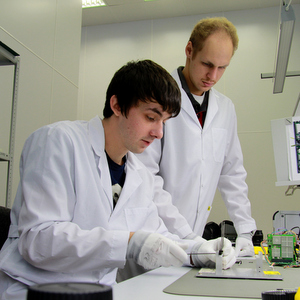The employees of Inter-University Department of Space Research, Samara University, have developed a nanosatellite training model that makes it possible for school goers to acquire engineering skills in the sphere of space technologies. The design solutions, used in the model, are identical to flight models of spacecraft in the format of CubeSat 2U. The finalists of the all-Russia competition “Sputnik”, who are going to Artek in April, will be the first ones to have the practical training cycle from assembly of a nanosatellite to telemetry data processing.

In Crimean Artek Samara University is realizing several educational programmes on the basis of three own laboratories working throughout the year: “Rocket Production”, “Electronics”, and “Robotics”. Moreover, 4th stage of the all-Russia competition with international participation “Sputnik” organized by the university will be held there from April 7 to April 28. 200 winners from all over Russia and abroad will come to the final. During the space shift the school goers, including those under the guidance of Inter-University Department of Space Research of Samara University, will get complete engineering experience of nanosatellite assembly, software setting, telemetry data processing and will get acquainted with other aspects of development and operation of space technology.
After the assembly of nanosatellite engineering model the school goers will conduct autonomous tests of different onboard systems with the help of debug board. Systems of power supply, connection, orientation and motion stabilization, navigation as well as onboard computer and workload (developed by the specialists of the department) are set separately on it. Then the youngsters will be able to check the working capacity of the board vividly as well as reprogram it and adjust the software from a personal computer.
The young engineers will also learn in practice why gauges are placed in this not that way, what information and of which type they issue, and what these data reflect. The school goers will orient the satellite in space against the longitudinal axis as well as determine its position upon data from the trackers.
The university scholars have prepared interactive imitation of the work of Spacecraft Control Centre for young engineers. Average time of satellite addressing at low orbits is 1,5 hours, and in visibility distance it is situated for 5-10 minutes. The school goers will have to act upon the same scenario. In certain time slots they will “see” nanosatellite and get telemetry, herewith, improper operation of onboard equipment will be imitated, and the operators will have to manage and take corresponding measures on preservation and restoration of connection with the spacecraft. If they do not have time to do it, then for some time the satellite will “go in the shadow of the Earth” and there will be no connection with it. But the youngsters will have time to process telemetry data, analyze it, and work out the further action plan.
Making the training model of the nanosatellite Samara University scholars made it vivid to the maximum extent. “On boards we added LEDs so that children could follow all the processes in the nanosatellite. For example, there is an indication that the power supply has reached the board. The indication is set on the system of orientation: it appears depending on the direction of the nanosatellite flywheel rotation”, Efim Ustyugov, Assistant Lecturer of Inter-University Department of Space Research, explains. “Much indication is present on the debug board. There are also controlled LEDs, which allow the school goers following visually when the code will reach a certain stage and will go further”.
Understanding that the school goers will have to deal with the serious equipment the developers of the model have thought about security. “We protected all the elements from statics, developed the new architecture of the onboard systems, allowing to conduct assembly without the use of onboard cable network”, Efim Ustyugov explained.
For reference
Nanosatellites in the format of CubeSat weigh from 1 to 10 kg. They are being made by a modular means and are launched into space predominantly for scientific and educational aims. The “filling” of the educational model of nanosatellite developed at Samara University consists of the onboard computer, power supply system, and rechargeable battery pack, communications system with the navigation receiving set, control system of magnetic coils, flywheel control block, and the debug display.


